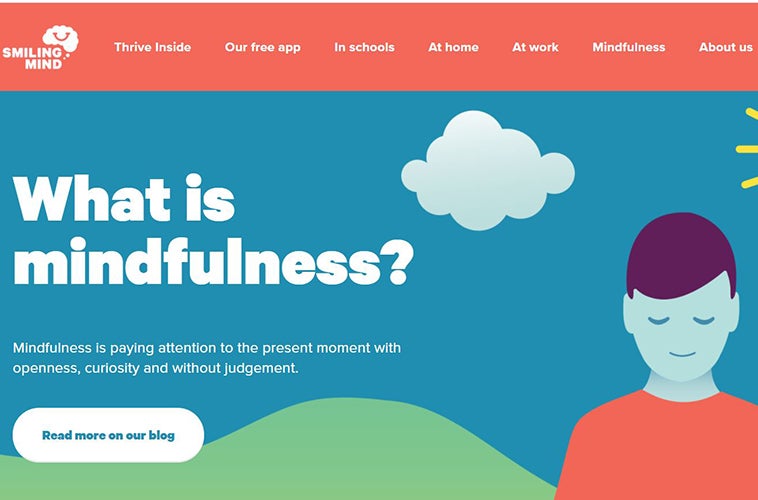
Practical tips to bring mindfulness into your day
9 September 2020
Mindfulness. It’s one of those ‘buzz’ words a lot of us have heard, and yet it remains arguably misunderstood. So, what is it? Can it improve your life? And, can one be ‘mindful’ without having to shut the door, light a candle and think of nothing for hours?
Smiling Mind defines mindfulness as ‘paying attention to the present moment with openness, curiosity and without judgement’. When we talk about being mindful, we’re not referring to “switching off” or “stopping” ourselves from thinking – in fact, paying close attention is the hallmark quality of mindfulness.
The benefits of mindfulness, particularly to those with a packed schedule (for instance, students!) are countless and varied. Mindfulness has been shown to increase happiness and compassion, improve attention and memory, boost our immune systems and slow the effects of ageing. How, then, can we make the practice of mindfulness a daily habit?
We’re glad you asked.
Study mindfully
Have you ever found yourself reading a book and suddenly realised you can’t recall the entire last page? You’re not alone. During times of stress our minds are rarely ‘on task’… they’re caught up in worry about the future, assessments that are due in a week, projects we need to get started on at work, something our mum said to us last week, whether it’s been too long since you checked Instagram…
This is called mindlessness, or being in “default mode”. It’s the opposite of mindfulness, and it often creates stress and anxiety. Our minds are anywhere but in the present moment which – by the way – is the only one that really counts.

To bring your awareness back to the here and now, so you can be more productive and boost your study efficiency, try the following:
1. Breathe
Sit back in your chair, let go of any tension you might feel around your neck and shoulders. Take a slow, deep breath in for 4 seconds, hold for 2, and release for 6.
2. Notice your environment
Getting into the study zone might require you to make some changes to the room you’re in. Make sure you’re free from distractions and have an ergonomic, comfortable space you can remain in for at least 30 minutes.
3. Unplug
It can be challenging, but trust us – putting your device into flight mode or switching it off will make sure you won’t receive notifications that will, ultimately, take you away from the present.
4. Take breaks
Holding concentration for a prolonged time, however mindfully, can still be exhausting. Break up your study sessions regularly by having a stretch or eating a small snack.
Be informally mindful
Bringing mindfulness into your day is easy. If we’re paying attention to what’s going on around us, in a non-judgemental and accepting way, then we’re being mindful. We’re so used to being on autopilot that a lot of the time we’re oblivious to what’s happening in the present moment.
Take walking, for instance. Quite often, we use the time to worry rather than enjoy the feeling of walking. Try this next time you go for a walk:
- Notice your feet. Feel them as your legs pick them up, and place them back on the ground, one after the other.
- Feel your body. Really pay attention to how your body feels as it moves through space.
- Look around you. Now I mean REALLY look. Notice what’s happening around you – are there other people? Are there dogs off their leads? Is the sun filtering through the trees, casting rays of light and gently warming your face? Whatever you notice, pay attention to it.
- Connect with the present. Thoughts will come and go while you’re doing this, and that’s okay. Just notice where they are and bring your attention gently back to your feet, body and surroundings.
Eating mindfully
Another example of how you can start to bring mindfulness into your day is to eat mindfully. Eating is something we do multiple times throughout the day, which makes it an excellent opportunity to practice mindfulness, but usually, we’re eating out of habit rather than enjoyment. Try this next time you eat:
- Come to your senses. When you’re cooking your meal, be attentive to the colours, textures, smells and even the sounds the different foods make as they’re being cooked.
- Savour it. Take smaller, slower bites than you usually would, and pay attention to all the flavours as they fill your senses. You can enhance the flavour of food by closing your eyes and breathing deeply through your nose if that doesn’t feel too awkward.
- Chew thoroughly. Keep chewing your food until it’s released all of the flavours it has to offer – if it helps, this is usually 20 to 30 times for most foods (if you’re generally a fast eater, this step might be hard but trust us). Being aware while walking and eating means you’ll be spending a good part of your day being mindful, without having to break routine!
Meditating: How is it connected to mindfulness?
A mindfulness blog wouldn’t be a mindfulness blog without a quick word about meditation. While it’s true we can be mindful each day without meditation; it’s the formal practice of mindfulness that can fast-track changes in the brain.
10-minute mindfulness meditation can deactivate unnecessary stress processes in the brain that promotes fear and anxiety, and it can activate processes responsible for focus and decision-making.
Resources for Mindfulness
Before you start, Smiling Mind, a 100% not-for-profit Australian resource for mindfulness, offers some helpful tips for you to get the most out of your meditation. When it comes to mindfulness apps and resources, there are more available than you could shake a stick at. However, most will focus their meditations on the top 3 methods that can teach your brain to stay in (or return to) the present moment.

Top 3 methods of meditation
Focused attention
The most common form of mindfulness meditation, with this method, focus on your breath (which, along with your body, is firmly present in the here and now). For instance, you might find it easy to pay attention to the rise and fall of your chest or shoulders, or the coolness of the air as it enters your nostrils.
Body scan
With this method, begin by bringing your attention to the soles of your feet as they rest on the floor. Slowly, ‘scan’ your attention upwards through your body, noticing if you hold any tension without judgement. Take as much time as you need to, and if your mind wanders gently bring your awareness back to the body.
Noting
Mindfulness recognises two main environments: the external environment in which things are happening around you and can be detected by the five senses, and the internal environment – thoughts and feelings. With noting, sit peacefully and become aware of what you feel emotionally, and what thoughts are coming and going. It may be tricky at first, but the key here is to simply become aware of whatever you’re thinking and feeling with curiosity, acceptance and kindness.
How to get the most out of your practice
To get the most out of your practice, we recommend that you meditate twice per day, perhaps first thing in the morning and again after work or study.
Remember, the benefits of bringing mindfulness into each day include increasing happiness, improving attention and memory, boosting our immune systems and slowing the effects of ageing. What’s more, mindfulness helps us to be more compassionate with ourselves and others – it really will change your life.
Enjoy your practice!
